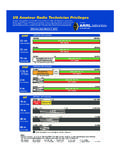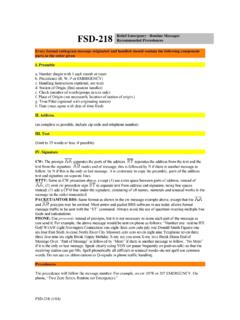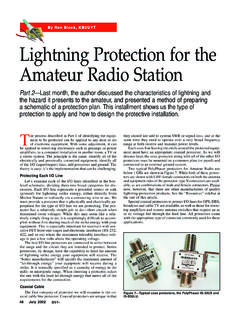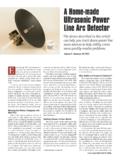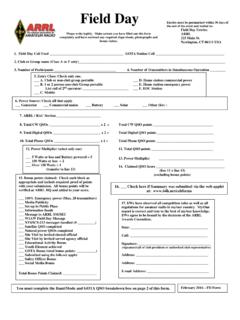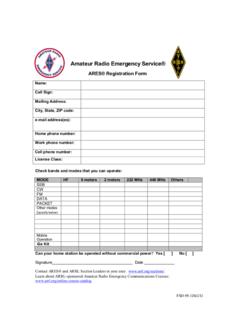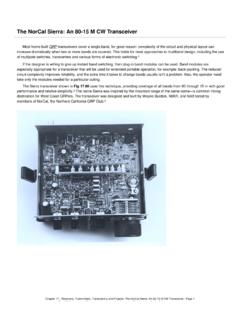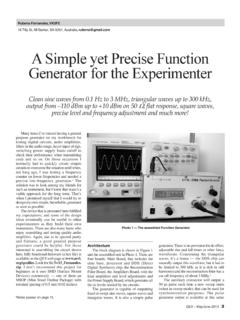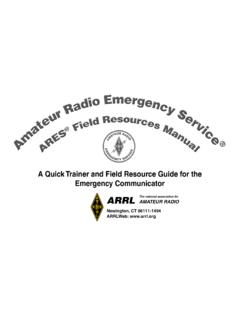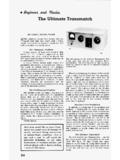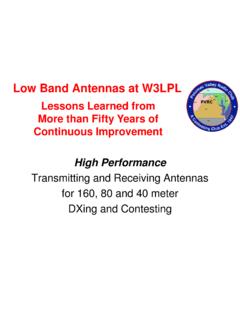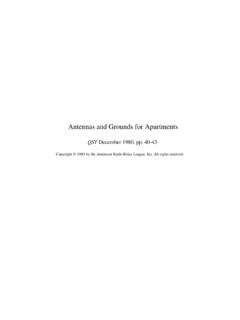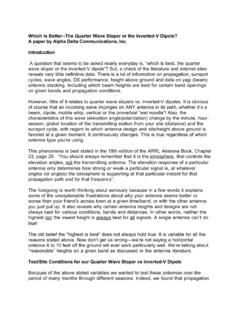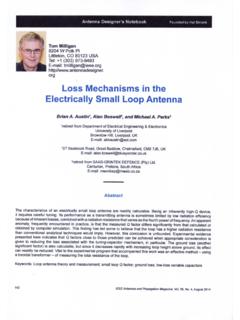Transcription of Antennas 101 “Don’t Be a 0.97 dB Weakling!” - …
1 Antennas 101 The Basics Ward Silver N AX Antennas 101 2 The Basics - 1 Antennas radiate (or receive) because electrons are accelerated (or are caused to accelerate) in the antenna s elements Radio or electromagnetic waves are both an E- (electric) and H- (magnetic) field Electrons move parallel to E-fields Strongest radiation from accelerating electrons linearly (back and forth) 2013 Antennas 101 3 The Basics - 2 The orientation of the E-field determines the polarization of the wave because that s what makes the electrons move (current) Antennas transmit & receive radio waves in the same way The radiation pattern shows how Antennas distribute energy in space 2013 Antennas 101 4 The Basics - 3 deciBels (dB) = 10 log (power ratio)
2 Impedance = ratio of Voltage to Current Feed point - place where power is applied 2013 Antennas 101 5 The Basics - 4 Azimuthal Pattern 2013 -1 dB from the maximum gain reference value Antennas 101 6 The Basics - 5 Elevation Pattern 2013 Antennas 101 7 The Basics - 6 Front-to-Back, Front-to-Side, and Front-to-Rear ratios Front-to-Rear ratio based on an average across 90 or 180 degrees behind the antenna in the pattern s rear quadrant(s) 2013 Antennas 101 8 The Basics - 6 2013 Front Side Back Rear Antennas 101 9 The Basics - 6 Beamwidth - angular width of main lobe Angle between the two points at which power is that at the peak (-3 dB points) 2013 Antennas 101 10 The Basics - 6 2013 Beamwidth 68 - 3 dB Antennas 101 11 Antennas 101 11 The Basics - 7 Gain measures re-distribution of energy Gain is a comparison of Antennas Gain is always with respect to a reference dBi (isotropic), dBd (free-space /2 dipole)
3 /2 dipole has dBi gain Ground-plane gain equivalent to /2 dipole 3-element Yagi may have up to 5 dBd gain 2013 Antennas 101 12 QUESTIONS?? 2013 Antennas 101 13 The Dipole - 1 Oldest and simplest form of antenna Di (two) Pole (voltage polarity) Usually 1/2-wavelength long Similar to a vibrating string s fundamental Current maximum in the middle Voltage maximum at the ends Pattern repeats every 1/2-wavelength Direction or amplitude is reversed 2013 Antennas 101 14 The Dipole - 2 1/2 wavelength Current maximum (I) Voltage minimum (V) feed point /2 A /2 /2 B C I V IMPORTANT!
4 !! 2013 Antennas 101 15 The Dipole - 3 Free-space wavelength ( ) = c / f or 300 / f in MHz (in meters) /2 = 492 / f in MHz (in feet) Length-to-diameter effect Makes the antenna a little longer electrically Thicker conductors are longer electrically Effect of height on electrical length 460/f to 490/f (rarely 468/f) 2013 Antennas 101 16 The Dipole - 4 Radiated energy is strongest perpendicular to an electron s motion electrons move along the length of a dipole radiation strongest broadside to the dipole 2013 Antennas 101 17 Radiation Pattern Dipole Axis Directions of Minimum Radiation The Dipole - 4 Directions of Maximum Radiation 2013 Antennas 101 18 The Dipole - 5 Feed point impedance varies with position High at the ends and low in the middle Resonance feed point impedance all resistive.
5 No reactance Z = R + j 0 ohms Doesn t matter what R is (any value, not just 50 ) 2013 Antennas 101 19 The Dipole - 5 1/2 wavelength Current Maximum (I) Voltage Minimum (V) feed point /2 A /2 /2 B C I V 2013 High Z Low Z H H H L L Antennas 101 20 The Dipole - 6 Inverted-Vee is a bent dipole Radiation pattern adds the effect of ground gain from reflections Can add as much as 6 dB over free space Free-space gain best comparative measure Ground gain varies with height and with ground conductivity 2013 Antennas 101 21 35 The Dipole - 6 /2 Inverted-Vee Radiation Pattern ground /2 2013 Antennas 101 22 QUESTIONS?
6 ? 2013 Antennas 101 23 The Ground Plane - 1 Start with a vertical dipole in free-space Cut off one half of the dipole Replace the missing half with a ground plane or counterpoise Omnidirectional if oriented vertically Also called a monopole 2013 Antennas 101 24 The Ground Plane - 2 2013 Antennas 101 25 The Ground Plane - 3 2013 Antennas 101 26 The Ground Plane - 4 Equal radiation broadside Nulls along the axis 2013 Antennas 101 27 The Ground Plane - 5 Length (ft) 234 / f (MHz) 231 / f if #14 wire used, - 221 if 5/8 tubing Feed point impedance 35 if radials used, sloping increases feed point impedance approximately 45 of droop gives best match halfway between dipole (72 ) and ground plane (35 )
7 2013 Antennas 101 28 Useful References and Books ARRL Publications antenna Book, Basic Antennas Compendium and Classics series RSGB Publications Practical Wire Antennas and HF Antennas for all Locations CQ Communications Sevick s and Maxwell s books on xmsn lines, baluns Vertical Handbook, All About Quads 2013 Antennas 101 29 Useful On-Line References ARRL Technical Information Service and Cebik s web site - Part of the site (subscription) Antennas and TowerTalk reflectors at 2013 Antennas 101 30 Thank You!
8 2013
